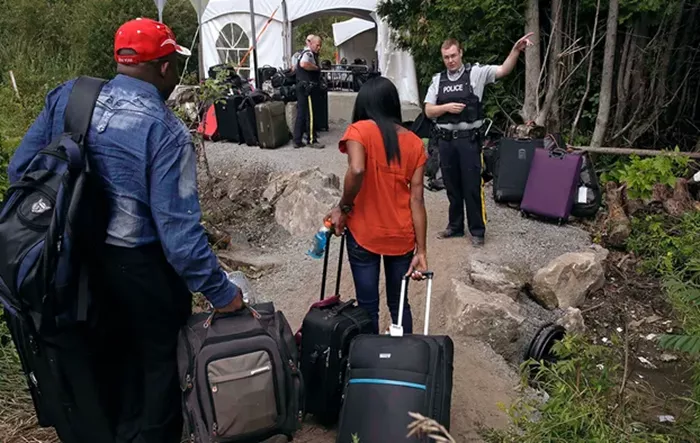As Ireland heads toward its General Election on November 29, immigration is emerging as a central issue, with the ongoing challenges surrounding asylum seekers, refugees, and the nation’s strained immigration system.
Since the outbreak of war in Ukraine in 2022, Ireland has welcomed refugees fleeing the conflict. However, this influx coincided with an increasing number of asylum seekers, which has placed significant pressure on the country’s immigration infrastructure.
Protests at planned International Protection Accommodation Service (IPAS) centres have turned heated, with many local residents claiming they were not consulted about these developments. They argue that their concerns have been overlooked or silenced by individuals with differing agendas.
Growing Numbers and Political Tension
Immigration has been a focal point in elections across the globe this year, and Ireland is no exception. The country’s response to global migration trends, particularly the war in Ukraine, has sparked intense political debate.
In 2020, the Irish government proposed a new model for asylum accommodation, aiming to house 3,500 applicants annually. However, the plan was quickly abandoned as the scale of migration escalated, with the number of asylum seekers jumping from 1,342 in October 2020 to 11,142 just two years later.
The Russian invasion of Ukraine in February 2022 prompted a surge of refugees fleeing to European countries. Initially, government officials anticipated around 10,000 Ukrainians might seek refuge in Ireland. Today, that number has exceeded 100,000.
The ‘Thousand Welcomes’ Faces Strain
In the early months of 2022, Ireland’s communities responded with open arms, converting convents and community halls into refugee accommodation. Many Ukrainian refugees were quickly integrated into local schools, sports teams, and daily life. However, tensions have risen recently, particularly in smaller towns and villages, where some residents have resisted efforts to relocate refugees from other areas.
Concerns have been raised about the government’s integration strategy, especially after community-led initiatives had already successfully supported refugee integration. Locals feared that their communities were being unfairly burdened with asylum seekers, with some even questioning the government’s handling of the issue.
Immigration Amid a Series of Crises
Ireland’s immigration crisis comes on top of multiple challenges facing the country. In the aftermath of the pandemic, the country is grappling with rising living costs, a housing shortage, and severe traffic congestion. The sudden surge in asylum seekers has further strained an already overstretched system, forcing the government to house many asylum seekers—mainly single men—in vacant properties, often in remote areas with limited resources.
For many Irish citizens, the influx of refugees has led to heightened frustration, as they contend with their own difficulties, including overcrowded public transport and long commutes. Some have voiced concerns about the availability of resources and the impact of the rising numbers on local services.
However, these concerns have often been dismissed as xenophobic or racist, leaving a gap in the political debate. This vacuum has allowed extremist voices to exploit public anxiety and stoke division.
Government Struggles with Accommodation and Integration
The government’s response has been mixed. While some politicians have called for a pause on asylum seekers’ arrivals, opposition parties have struggled to present a unified stance on the issue. The Department of Integration has faced immense pressure in trying to accommodate the growing number of asylum seekers, with little support from other government departments.
In December 2023, the government was forced to halt emergency accommodation for single male asylum seekers due to capacity constraints. As of now, nearly 3,000 individuals remain unaccommodated, nearly the same number originally outlined in the government’s 2020 plan.
A Divided Response to Immigration Policy
This year, the government published a new strategy for IPAS accommodation, setting out a vision to reduce reliance on private accommodation providers. It aims to create 14,000 State-run beds by 2028. However, proposed sites like Thornton Hall have been met with legal challenges from local communities, delaying progress.
Minister for Integration Roderic O’Gorman has reassured the public that initial fears of refugees disrupting local communities are largely unfounded, citing successful integration stories. Yet, the growing divisions and tensions in many communities tell a different story. In some areas, integration has been hindered by hostility from local residents, leading to intimidation and social isolation of both refugees and the volunteers who support them.
Political Challenges Ahead
As the election approaches, political parties face the difficult task of crafting immigration policies that balance public concern with international human rights obligations. The challenge is not only to address the immediate needs of refugees and asylum seekers but also to rebuild trust and unity within local communities that feel increasingly divided over the issue.
In the coming weeks, Ireland will have to grapple with these complex questions, and the way political leaders handle immigration in the election could shape the future of the country’s immigration policies for years to come.
Related topics:
- EU Struggles with Worker Shortages Amid Rising Anti-Immigrant Sentiment
- Industries Most Vulnerable to Trump’s Immigration Crackdown
- Looking Ahead: The Economic Impact of Immigration Through Two Key Indicators


